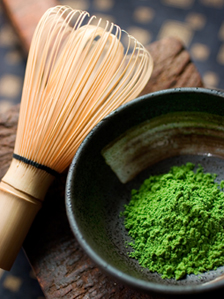The Ancient Tea with Modern Benefits

THE DRINK OF BUN (ART) AND BU (ARMS) What is original to Japan's powdered tea is who first drank it and why. First, as with all fine things, it was the nobility. Then, for centuries, it was the warlords, known as shoguns. The priest Shuko (1422-1502) first introduced tea to Shogun Ashikaga Hoshimasa, a man of great culture and a keen fighter, and that set the path for matcha to be the conduit, for centuries, between culture (bun) and arms (bu) among shoguns and their soldiers (samurai). While the bun and bu elements may seem odd to be part of an essential serene experience like tea drinking, an ancient Chinese saying clarifies: "from of old there has been the practice of following the arts of peace on the left hand and the arts of war on the right hand. Both of these must be mastered." Tea gatherings were made not just to enjoy tea, but often as a calming experience before entering battle. And, they were political. Shoguns would sit their allies in the coveted guest positions to perpetuate their demand for allegiance and loyalty and demonstrate both social and political hierarchy. In times of war, there was an ironic twist: potential enemies were invited to tea as a gesture of creating harmony and breaking down social differences, thus creating an aura of equality and perhaps the introduction to diplomacy. To give, or receive, highly prized tea equipage was a hallmark of hospitality and friendship especially among shoguns, although not everyone was so inclined. Matsunaga Hisahide (1510-1577) refused to give his famous tea kettle to Shogun Oda Nobunaga saying that he would rather take it with him to hell. When, under attack by Nobunaga, he decided to kill himself by throwing the kettle against the wall and setting his castle afire. He, and his beloved kettle, so much a part of his sense of himself, both perished.
TEA MAKING CONTESTS One earlier social construct among both shoguns and the public was the tea making contest, tôcha, which began with the Kamakura period (1192-1333). The goal was to determine who could distinguish which teas came from which region, and often, which season. Much to the chagrin of monks and true tea enthusiasts, these tasting contests soon took on heightened elements of competition like wagering and, to some nobility and military, crossed social and ethnic boundaries blurring the lines of carefully crafted hierarchies. To deflect this behavior, rules were established, and more formal, more conservative gatherings began. The name, too, was changed to chakabuki. Developed to increase one's palate to the heights of discrimination, these contests were created within the framework of the Zen teachings and considerably more civility. Chakabuki was conducted in a large tea room with at least four guests, a host and a recorder for the tasting results or, to be honest, the guesses. Three koichas, thick blends of matcha made with hot water, and usucha, matcha whipped with a whisk, were the typical menu (koicha, because of its thickness, requires kneading to blend with the hot water). A third tea, kyaku or "guest" tea, was also sampled. Koicha was always served first followed by usucha. Koicha was served from a larger vessel and shared among the guests while usucha was served in individual bowls to each guest. While there was no "best of," most participants in chakabuki would cite quality elements between sencha and gyokuro types of matcha. Because matcha is now made only from gyokuro, one could not have an identical chakabuki today, but one could certainly taste different brands, different seasons or different ages of matcha and fuel a discussion of how each tastes or how each one's fragrance appeals or not.
HOW TO TASTE MATCHA Matcha is refreshing, stimulating and delicious. From the first whiff of its grassy sweetness when a can is first opened, to the first sip when the tea is brewed, matcha is a singular tea-tasting experience. The Urasenke school suggests that first taste should be with the tip of the tongue, sensing the first shock of flavor. Next comes how the tea "touches the hara," the center of one's being (described as two fingers below the navel). Aftertaste, back-of-the-mouth feel and other similar tea-tasting vocabulary and constructs are possible.
HOW TO BREW The proper utensils are essential for preparing matcha that tastes as delicious as it looks beautiful. Buy the finest you can afford, and keep refrigerated for freshness. When ready to use, first heat the water. While the kettle heats, place the matcha in a natsume, a small lidded caddy just for this purpose. Use a traditional chashaku tea scoop, of bamboo, wood, or ivory, to transfer tea from its package into the tea caddy. Next, comes a chawan, preferably ceramic, a bowl that should be taller in winter, wider in summer, so that the tea stays warmer in winter and cools in summer. Using the chashaku, measure out tea for each person and put it into the cha-wan. Hold the bamboo whisk upright and gently stir the tea and water mixture into a froth.
DIRECTIONS: Heat the water to 170°F. In the bowl, place 1/4 teaspoon of the powdered tea, pour on 4 ounces of hot water or more to taste. Whisk and drink immediately, using 3 or more sips. For even more matcha info, check out our TeaClass page on the topic.
